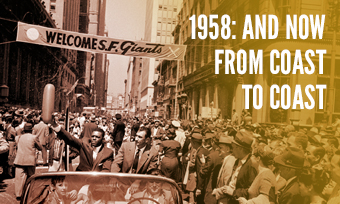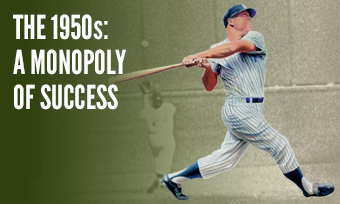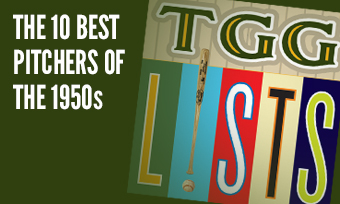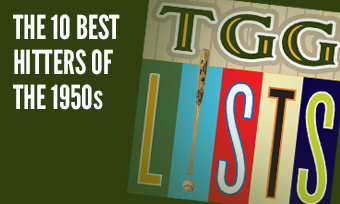The Yearly Reader
Leaders and Honors, 1958
Our list of baseball’s top 10 hitters and pitchers in both the American League and National League for the 1958 baseball season, as well as the awards and honors given to the game’s top achievers of the year.
The National League’s Top 10 Hitters, 1958
Bold type in brick red indicates league leader.
1. Willie Mays, San Francisco
Key Numbers: .347 average, 121 runs, 208 hits, 33 doubles, 11 triples, 29 home runs, 96 RBI, 78 walks, 31 stolen bases.
Not even a blistering start in which he hit .400 into mid-June could keep Mays, a transplanted “New Yorker,” from becoming adapted by Giants fans who greeted him as coolly as the San Francisco fog.
2. Ernie Banks, Chicago
Key Numbers: 154 games, .313 average, 617 at-bats, 119 runs, 193 hits, 23 doubles, 11 triples, 47 home runs, 129 RBIs, .614 slugging percentage.
It seemed all too understandable that Banks, who never played in a postseason, would became the first NL MVP recipient to play for a sub-.500 team. (He’d become the second such player the following year.)
3. Hank Aaron, Milwaukee
Key Numbers: .326 average, 109 runs, 196 hits, 34 doubles, 30 home runs, 95 RBIs.
A relatively quiet year for Hammerin’ Hank, with a set of numbers that 99% of the other major leaguers would be shouting for joy over.
4. Ken Boyer, St. Louis
Key Numbers: .307 average, 101 runs, 175 hits, 21 doubles, 9 triples, 23 home runs, 90 RBIs, 11 stolen bases.
With sunset approaching for an aging yet still effective Stan Musial, Boyer grabbed the mantle as the Cardinals’ primary, everyday offensive weapon—and with his first of four Gold Gloves, wasn’t all that bad at third base, either.
5. Harry Anderson, Philadelphia
Key Numbers: .301 average, 80 runs, 34 doubles, 6 triples, 23 home runs, 97 RBIs, 95 strikeouts.
The Phillies’ latest one-year wonder at the plate, following Stan Lopata and Ed Bouchee; Anderson shined in what would be his second of only three full-time campaigns at the major league level. He’s also the last player to date (and likely for a long time) to lead the majors in strikeouts with less than 100.
6. Bob Skinner, Pittsburgh
Key Numbers: .321 average, 93 runs, 170 hits, 33 doubles, 9 triples, 13 home runs, 70 RBIs, 12 stolen bases.
While Frank Thomas got most of the marquee love at Forbes Field, Skinner emerged as the most complete Pirate at the plate, doing a little bit of everything and a little bit more.
7. Frank Thomas, Pittsburgh
Key Numbers: .281 average, 89 runs, 26 doubles, 35 home runs, 109 RBIs.
The 29-year-old slugger set a career high in home runs—but it could have been far more; Forbes Field’s macro-distant field dimensions limited him to just nine dingers at home.
8. Richie Ashburn, Philadelphia
Key Numbers: .350 average, 98 runs, 215 hits, 24 doubles, 13 triples, 2 home runs, 33 RBIs, 97 walks, 30 stolen bases, 12 caught stealing, .440 on-base percentage.
Shades of 1930: The last-place Phillies led the NL in batting average and hits, thanks mainly to Ashburn.
9. Orlando Cepeda, San Francisco
Key Numbers: .312 average, 88 runs, 188 hits, 38 doubles, 25 home runs, 96 RBIs, 15 stolen bases, 9 sacrifice flies.
One of four everyday rookie Giants, Cepeda became an instant favorite in the Golden Gate City because, unlike Willie Mays, he previously never wore a cap with “NY” upon it.
10. Frank Robinson, Cincinnati
Key Numbers: .269 average, 90 runs, 25 doubles, 6 triples, 31 home runs, 83 RBIs, 10 stolen bases.
In a year where the Reds’ vaunted slugging core went into brownout mode with a 35% drop in home runs, Robinson maintained the power as the only team member hitting over 16.
The American League’s Top 10 Hitters, 1958
1. Mickey Mantle, New York
Key Numbers: .304 average, 127 runs, 42 home runs, 97 RBIs, 129 walks, 13 intentional walks, 120 strikeouts, 18 stolen bases.
With the Dodgers and Giants departed, Mantle finally claimed, without argument, that he was the best center fielder in New York.
2. Rocky Colavito, Cleveland
Key Numbers: .303 average, 80 runs, 26 doubles, 41 home runs, 113 RBIs, 84 walks, .620 slugging percentage.
Cleveland fans had starry-eyed visions of Colavito, in his breakout year, as the next Mantle—and maybe even the next Whitey Ford; he threw three scoreless innings in an emergency relief stint.
3. Jackie Jensen, Boston
Key Numbers: .286 average, 83 runs, 31 doubles, 35 home runs, 122 RBIs, 99 walks.
Jensen added the AL MVP to a résumé that also included appearances in the Rose Bowl and World Series.
4. Bob Cerv, Kansas City
Key Numbers: .305 average, 93 runs, 20 doubles, 7 triples, 38 home runs, 104 RBIs.
Two years earlier, Cerv was dealt from the Yankees to the A’s when Casey Stengel sidled up to him and said, “Nobody knows this, but one of us has been traded to Kansas City.” After his fantastic year in the Midwest, the Yankees were, for the moment, perhaps wishing that it was Stengel who left.
5. Ted Williams, Boston
Key Numbers: 129 games, .328 average, 81 runs, 26 home runs, 85 RBIs, 98 walks, .458 on-base percentage.
Williams enjoyed his last batting title in the same year the Red Sox enjoyed their last winning record for the next nine years.
6. Roy Sievers, Washington
Key Numbers: .295 average, 85 runs, 39 home runs, 108 RBIs.
The Senators’ slugger signed the biggest one-year contract ($36,000) in franchise history to date; if it wasn’t for a mild September, he would have reached 40 homers for a second straight season.
7. Pete Runnels, Boston
Key Numbers: .322 average, 103 runs, 183 hits, 32 doubles, 5 triples, 8 home runs, 59 RBIs, 87 walks.
Whereas Sievers longed for a trade to the Red Sox and join Ted Williams that never became reality, Runnels ended up living the fantasy and saw his batting average hike up nearly 100 points.
8. Minnie Minoso, Cleveland
Key Numbers: .302 average, 94 runs, 168 hits, 25 doubles, 24 home runs, 80 RBIs, 15 hit-by-pitches, 14 stolen bases, 14 caught stealing.
Exiled from Chicago and spacious Comiskey Park, Minoso arrived in Cleveland and set a personal mark for home runs.
9. Al Kaline, Detroit
Key Numbers: .313 average, 84 runs, 170 hits, 34 doubles, 7 triples, 16 home runs, 85 RBIs.
Though the Tiger star’s numbers continued to trend downward, he was still a viable enough threat that he made his fourth of 15 All-Star Game rosters.
10. Yogi Berra, New York
Key Numbers: 122 games, .266 average, 22 home runs, 90 RBIs.
Even as the wear-and-tear of so many years playing everyday catcher began to catch up, Berra was still efficient enough to nearly drive in 100 runs with 30-plus games to spare.
The National League’s Top 10 Pitchers, 1958
1. Lew Burdette, Milwaukee
Key Numbers: 2.91 ERA, 20 wins, 10 losses, .667 win percentage, 40 appearances, 36 starts, 275.1 innings, 50 walks, 39 grounded into double plays.
Burdette was 11-2 with 11 complete games over the final two months to publish his first of two consecutive 20-win seasons.
2. Warren Spahn, Milwaukee
Key Numbers: 3.07 ERA, 22 wins, 11 losses, .667 win percentage, 36 starts, 23 complete games, 290 innings, 1 stolen base allowed, 29 grounded into double plays.
Spahn became the first nine-time 20-game winner among southpaws; the career .194 hitter even had his bat magic in sync, pushing a .333 mark over 108 at-bats with nine extra-base hits.
3. Bob Friend, Pittsburgh
Key Numbers: 3.65 ERA, 22 wins, 14 losses, 38 starts, 274 innings, 61 walks, 36 grounded into double plays.
The rest of the Pirates began to get with the program Friend had adopted a couple of years earlier, finishing above .500 for the first time in 10 years; his 22 wins were the most by a Pirate since Burleigh Grimes in 1929.
4. Sam Jones, St. Louis
Key Numbers: 2.88 ERA, 14 wins, 13 losses, 35 starts, 250 innings, 107 walks, 225 strikeouts.
Not to be confused with Sad Sam Jones circa 1920, this Sam—who went by “Toothpick Sam” because it always seemed he had one in his mouth—became the first NL pitcher to record 200-plus strikeouts in 17 years.
5. Stu Miller, San Francisco
Key Numbers: 2.47 ERA, 6 wins, 9 losses, 41 appearances, 20 starts, 182 innings.
Temporarily safe from the knock-down gusts of Candlestick Park (which had yet to be built), Miller won only six of his 20 starts and none of his 21 bullpen appearances—thus notching the fewest wins by an ERA leader until Joe Magrane in 1988.
6. Robin Roberts, Philadelphia
Key Numbers: 3.24 ERA, 17 wins, 14 losses, 34 starts, 21 complete games, 269.2 innings, 51 walks.
After two years of taking a constant pounding that suggested a career burnout, Roberts briefly returned to fine form—and for the first time in five years didn’t lead the NL in home runs surrendered.
7. Bob Purkey, Cincinnati
Key Numbers: 3.60 ERA, 17 wins, 11 losses, 34 starts, 250 innings, 49 walks.
Grabbed from the Pirates, Purkey immediately established himself as the Reds’ staff ace—a position he would by and large maintain for the next five seasons.
8. Jim Brosnan, Chicago-St. Louis
Key Numbers: 3.35 ERA, 11 wins, 8 losses, 7 saves, 41 appearances, 20 starts, 166.2 innings.
It wasn’t quite the magnitude as Lou Brock-for-Ernie Broglio, but Brosnan’s move to the Cardinals for a fading Al Dark would work one-sidedly in St. Louis’ favor.
9. Ron Kline, Pittsburgh
Key Numbers: 3.53 ERA, 13 wins, 16 losses, 32 starts, 237.1 innings, 92 walks, 14 intentional walks.
In a solid but bittersweet campaign, Kline had one of roughest games of 1958—going the distance in a 14-inning loss at Philadelphia in which he walked a major league season-high nine batters while striking out a major league season-high five times in five at-bats.
10. Johnny Antonelli, San Francisco
Key Numbers: 3.28 ERA, 16 wins, 13 losses, 3 saves, 41 appearances, 34 starts, 241.2 innings.
Another bounce-back for Antonelli, having something of an up-and-down decade—though as an admitted hater of the San Francisco summer chill, he would have rather been back at the Polo Grounds.
The American League’s Top 10 Pitchers, 1958
1. Whitey Ford, New York
Key Numbers: 2.01 ERA, 14 wins, 7 losses, 29 starts, 219.1 innings, 0 stolen bases allowed, 13 caught stealing/picked off, 26 grounded into double plays.
Ford not only cut down on the walks that plagued him early in his career— resulting in a career-low ERA—but cut the number of steals committed on his watch all the way to zero; he’d do it again in 1959.
2. Billy Pierce, Chicago
Key Numbers: 2.68 ERA, 17 wins, 11 losses, 2 saves, 35 appearances, 32 starts, 19 complete games, 245 innings.
Pierce led (or co-led) the AL for the third straight year in complete games—and one of them, on June 27 against Washington, would have been a perfect one had he just gotten the 27th batter out. He didn’t.
3. Billy O’Dell, Baltimore
Key Numbers: 2.97 ERA, 14 wins, 11 losses, 8 saves, 41 appearances, 25 starts, 221.1 innings, 50 walks.
The Beltway was very generous to the young southpaw, who went 11-4 with a 2.20 ERA in 23 combined appearances at Baltimore and Washington.
4. Frank Lary, Detroit
Key Numbers: 2.90 ERA, 16 wins, 15 losses, 39 appearances, 34 starts, 19 complete games, 260.1 innings, 12 hit-by-pitches, 29 grounded into double plays.
The ultimate Kryptonite against the Yankees; in eight starts against New York, Lary was 7-1 with a 1.86 ERA. Against the rest of the AL, he was 9-14 with a 3.28 figure.
5. Bob Turley, New York
Key Numbers: 2.97 ERA, 21 wins, 7 losses, .750 win percentage, 31 starts, 19 complete games, 245.1 innings, 128 walks, 14 caught stealing/picked off.
Leading the AL for the fourth time in five years in opposing batting average, Turley finally got support from his teammates—and recognition from voters who gave him the Cy Young Award.
6. Arnie Portocarrero, Baltimore
Key Numbers: 3.25 ERA, 15 wins, 11 losses, 2 saves, 32 appearances, 27 starts, 204.2 innings.
After taking major league life on the chin in four tough years with the Philly/K.C. A’s, the sweet-sounding Portocarrero found relative solace in the spacious confines of Memorial Stadium.
7. Dick Donovan, Chicago
Key Numbers: 3.01 ERA, 15 wins, 14 losses, 34 starts, 248 innings, 53 walks.
It took a while for Billy Pierce’s faithful sidekick to warm up; he was 3-9 with a 4.52 ERA at the end of June—but 12-5 and 2.00 after.
8. Jack Harshman, Baltimore
Key Numbers: 2.89 ERA, 12 wins, 15 losses, 4 saves, 34 appearances, 29 starts, 236.1 innings, 24 grounded into double plays.
As deplorable as Harshman’s 2.7 runs per start was, it could have been worse without his own bat; he was fifth on the team in home runs, with six.
9. Dick Hyde, Washington
Key Numbers: 1.75 ERA, 10 wins, 3 losses, 19 saves, 53 appearances, 0 starts, 103 innings.
Confusing opposing batters with new a delivery and ball movement, Hyde was Dr. Jekyll compared to the otherwise hideous Senators pitching staff.
10. Cal McLish, Cleveland
Key Numbers: 2.99 ERA, 16 wins, 8 losses, 39 appearances, 30 starts, 225.2 innings.
A long and winding road for McLish, which began as an 18-year old for the wartime Dodgers (1944) with numerous minor-league stops to follow, finally came to an agreeable destination as a reliable member of the Cleveland rotation.









